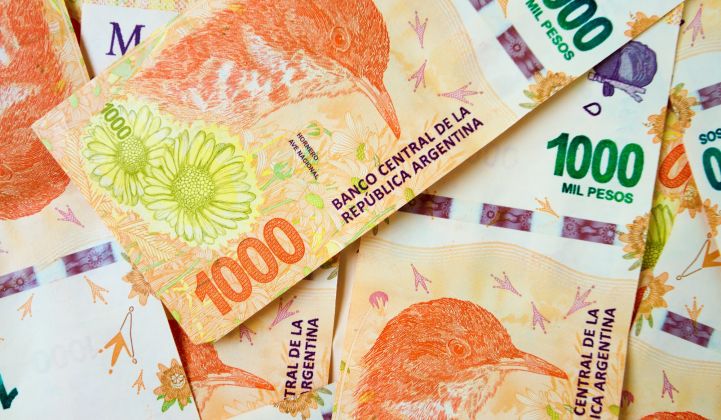Rampant inflation has put Argentina’s nascent renewable energy market in mortal danger, an analyst has warned. “Banks will be affected by the currency run, which will likely make long-term financing virtually impossible,” said Maria José Chea, a solar analyst with IHS Markit.
This month, Argentina’s central bank posted the highest interest rate in the world, 60 percent, in a bid to stem free-falling devaluation of the peso. The currency has dropped more than 50 percent in value against the dollar so far this year.
"A failing economy isn't good at all for renewables, particularly the new regulatory framework that's in place in the country," said Manan Parikh, an analyst with Wood Mackenzie Power & Renewables.
The rapid fall in the peso’s value threatens to overwhelm safeguards built into Argentina’s renewable energy program, RenovAr, specifically to deal with macroeconomic risks when it was created in 2015 to support a target of 20 percent renewable electricity by 2015.
Power-purchase agreements (PPAs) in RenovAr tenders have all been in U.S. dollars. Hence, Chea said: “In principle, the devaluation of the peso should not affect contracts that have been signed.”
Furthermore, the Argentinean government set up a Trust Fund for Renewable Energy or (‘Fondo Fiduciario para el Desarrollo de Energías Renovables’ or FODER in Spanish) to provide payment guarantees for all PPAs ahead of a 1-gigawatt renewable auction in 2016.
Argentina allocated ARS 12 billion (roughly $860 million at 2016 exchange rates) to FODER, which is also intended to offer project financing assistance.
On top of that, an International Bank for Reconstruction and Development guarantee, worth $480 million, was put in place to backstop any government failure to support the fund. These measures largely failed to boost investor confidence, however.
Argentinean renewable energy project developers found it hard to find finance, Chea said.
Latin America’s largest solar project, the 300-megawatt Cauchari solar plant in Jujuy, northwest Argentina, only went ahead after The Export-Import Bank of China stepped in with $331.5 million toward a total financing amount of $541.5 million.
But Cauchari was awarded in the first RenovAr round, before the present currency crisis, and also benefited from a green bond issued by Jujuy Province.
If financing renewable energy projects in economically unstable Argentina was already hard enough before the peso began to drop, there are now real fears that RenovAr projects yet to find financing will no longer be able to do so.
Dollar-denominated PPAs would not shield the renewables sector from dampened consumption and investment caused by high inflation and interest rates, Chea explained.
And despite FODER, “offtaker risk could be heightened if the country goes into a prolonged recession,” she commented.
Many developers awarded projects under RenovAr are small, local companies, Chea said, without the wherewithal to back developments on their balance sheets or to secure state-backed funding.
The expectation is that such developers will see project delays and cancellations as financing evaporates. “Investors who were already wary of the financial climate in the country may choose to wait until macroeconomic conditions become stable again,” said Chea.
It is unclear how long that might be. Chea said Argentina’s currency volatility is likely to continue until there is more clarity over whether the International Monetary Fund (IMF) will continue to support the country.
This month, Fitch Ratings said that talks were ongoing between the Argentine government and the IMF to strengthen an existing $50 billion standby arrangement for the country.
If approved, the disbursement could help increase liquidity, stabilize the exchange rate and allow the central bank to cut interest rates, Chea said. In return for its support, though, the IMF has demanded belt-tightening measures that are proving unpopular in Argentina.
Reuters reported that labor unions and social groups had taken to the streets in downtown Buenos Aires. “The outlook for Latin America’s third-biggest economy is grim, according to orthodox and left-leaning economists alike,” it said.
Perhaps surprisingly, though, there are still indications of continuing renewable energy project interest in the country.
The government has said it will launch a mini-RenvoAr auction round in October, putting 350 megawatts of wind and solar, 25 megawatts of biomass, 15 megawatts of biogas and 10 megawatts of small hydro on the block.
“The aim is to make project sizes smaller, between 500 kilowatts and 10 megawatts, so that additional transmission and distribution infrastructure isn't needed on an already taxed and aging grid,” said Wood Mackenzie's Parikh.
Investors without the nerve to enter government auctions might still be willing to invest in a private PPA market called MATER (for Mercado a Término de Energía Eléctrica de Fuente Renovable), for electricity users with power requirements in excess of 300 kilowatts.
The country has close to 2,100 large consumers, Parikh said, and companies such as Aluar Aluminio Argentino and Toyota Argentina have already taken steps to add renewable energy into their mix.
“To accommodate the initial demand from a clean energy target of 8 percent, some of Argentina's largest energy users have already begun developing or procuring renewable energy, opting out of their requirements with the distribution companies,” Parikh noted.




